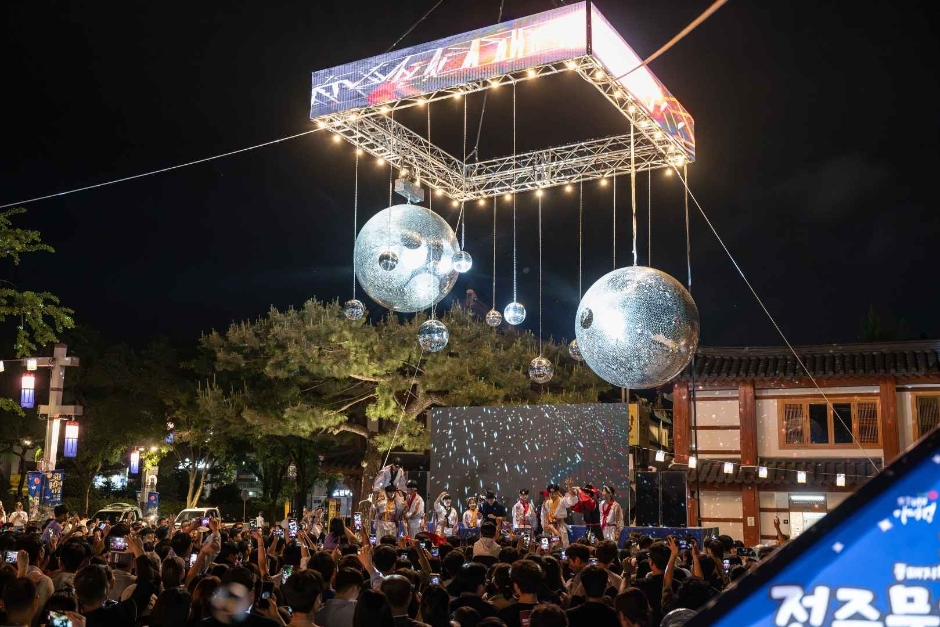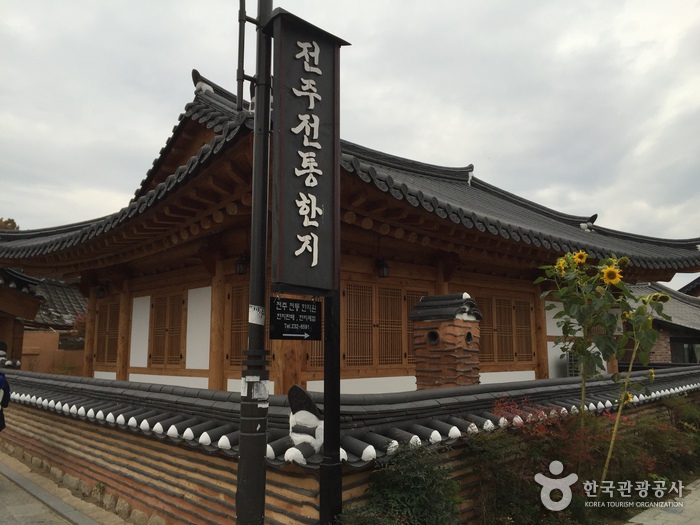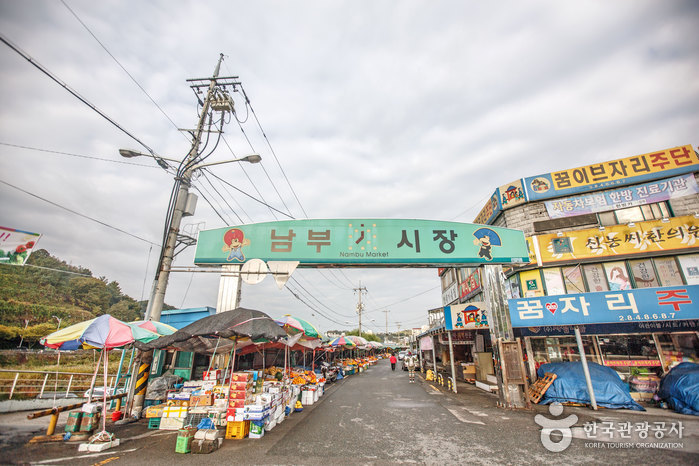Puerta Pungnammun de Jeonju (전주 풍남문)
3.3 Km 4539 2024-04-07
Pungnammun 3-gil 1, Wansan-gu, Jeonju-si, Jeonbuk-do.
La puerta Pungnammun se ubica donde estaba la puerta sur de la antigua Fortaleza de Jeonju. Sus primeras construcciones datan de los años 1734 y 1768, y tras ser parcialmente desmantelada por tareas de planificación urbana, finalmente recuperó su forma original en 1978.
Paseo Cultural Nocturno de Jeonju (전주문화유산야행)
3.3 Km 38547 2024-04-17
Taejo-ro 44, Wansan-gu, Jeonju-si, Jeonbuk-do.
063-232-9937
Este tour se dedica a la preservación y puesta en valor del patrimonio cultural coreano. Jeonju es una ciudad que alberga gran cantidad de sitios que son patrimonio histórico de la época de Joseon. Durante las noches que dura el tour, los visitantes pueden experimentar y conocer de cerca la historia de Corea y apreciar su legado ancestral.
Centro Tradicional del Hanji en Jeonju (전주전통한지원)
3.3 Km 14094 2024-04-07
Hanji-gil 100-10, Wansan-gu, Jeonju-si, Jeonbuk-do
Jeonju ha sido el mayor productor de papel tradicional hanji durante más de cien años. Aún mantiene esta orgullosa tradición y el Centro Tradicional del Hanji pretende preservar las técnicas tradicionales de fabricación de papel y ser el centro de la industria del hanji. Más del 80 por ciento del papel producido en el centro es exportado a Japón, y el resto se usa en Corea. El centro produce, expone y vende hanji para caligrafía, pinturas orientales y otros elementos artesanales.
Jeonju hanok house [Korea Quality] / 전주한옥숙박체험관 [한국관광 품질인증]
3.3 Km 1623 2024-04-07
56-1, Eunhaeng-ro, Wansan-gu, Jeonju-si, Jeonbuk-do
+82-10-3659-0055
Jeonjuhanok Korean House is a traditional Korean house built more than 60 years age, and it was recently remodeled for visitors to see and experience an old traditional Korean house. It’s conveniently located on the street called "Eunhaeng-ro" right in the middle of Jeonju Hanok Village for those visiting the area to take a tour of the hanok village. Although it's in the middle of the village, it's quiet inside because it's located at the end of a long, wide alley, which has the feel of an art gallery thanks to the lighting. There is a table in the yard in front of the ‘ㄱ’-shaped house. Behind the house is a café where breakfast is served. The house has an open space between the rooms called "toetmaru", which serves as a living room as in all traditional Korean houses. It’s where Koreans used to rest under the warm sunlight in the old days. The guests must pass through this "toetmaru" to get to the roms.
Jeonjuhanok Korean House has seven "ondol (floor-heated)” rooms with a loft. The rooms are clean and have a simple interior with a wooden ladder to the loft, which is a favorite place for most kids staying here with their parents. Each guestroom is furnished with a water purifier. The guesthouse serves toast, caffe Americano, fruits, and tea for breakfast.
Bukyungdang [Korea Quality] / 부경당 [한국관광 품질인증]
3.3 Km 225 2024-04-07
99-5, Hanji-gil, Wansan-gu, Jeonju-si, Jeonbuk-do
+82-10-5327-8736
Located at the heart of the Jeongju Hanok Village, Bugyeongdang is a beautiful traditional 60-year old Hanok.
Traditional floor, roof tiles, and jar stands next to stone walls, while small garden and flower beds reflect the architect couple's attentive hands. As a Hanok with one of the prettiest gardens in Jeonju Hanok Village, it is a good place to appreciate the garden flowers and enjoy the unique laid-back atmosphere of Hanok while sitting on the floor. The place is close to major tourist attractions including Imokdae, Gyeonggijeon, Jeondong Catholic Cathedral, and Hyanggyo.
The owner, who was born and raised in the Jeonju Hanok Village, describes must-go sites like a tour guide and introduces undiscovered great restaurants or things-to-do to the guests. As the owner, who had long been engaged in architecture, takes care of the Hanok, the building always stays clean and in good condition.
In the shared kitchenette, guests can prepare simple breakfast for themselves with the dishes and cups made by the wife of the owner herself. Luggage storage services before check-in and after check-out, and description of tourist attractions are provided.
Dan Kyung [Korea Quality] / 단경 [한국관광 품질인증]
3.3 Km 230 2024-04-07
99, Hanji-gil, Wansan-gu, Jeonju-si, Jeonbuk-do
+82-10-5304-4380
Beginning of brightness that is what Hanok Guesthouse Dankyung means. The name reflects the politeness and consideration of the people of Jeonju. It also carries the wish for the guests of the guesthouse to become polite and considerate as well.
Since it was built in June 1943, Dankyung has kept its original form intact through the turbulent period of Korea's liberation from Japanese colonization, Korean War, and modernization. Despite the traditional form, the approximately 70-year-old Hanok is convenient to use and is beautiful in shape, emitting its beauty and gracefulness to the visitors of Jeonju Hanok Village. Anyone staying in Dankyung will feel as if he/she has become a noble man/woman of old Korea.
The white birch garden at the entrance, maple tree, and apricot flower tree in the yard create a seasonal atmosphere. Dansil, Hyangsil, and Gyeongsil of the main building and Byeolsil and Dasil of the separate building are equipped with a wooden floor, giving off a delicate wood scent. The gallery opposite the garden displays artworks and provides a space for guests to have breakfast or drink coffee or tea. The rooftop of the gallery is a special place for guests so that they can enjoy an uninterrupted view of Jeonju Hanok Village over drinks.
GaEunChae2 [Korea Quality] / 가은채2 [한국관광 품질인증]
3.3 Km 204 2024-04-07
100-20, Hanji-gil, Wansan-gu, Jeonju-si, Jeonbuk-do
+82-10-6335-5267
Gaeunchae 2 is the sister accommodations of Gaeunchae and is located behind the Jeonju Korean Traditional Wine Museum. Completed in 2011, the traditional Hanok has soil walls and soil Ondol floors finished with traditional Hanji wallpaper and Hanji floor paper for greater traditional beauty. The exposed rafter and gray wall design make for the unique interior atmosphere of Hanok. Sculptures such as stone lantern and stone tiger in the garden, old rectangular stone, and terrace stone in the yard make the Hanok even more elegant. The small floor in the room just in front of the door is a versatile space where one can put luggage or sit and have a chat.
Being situated close to the busy Taejoro in Jeonju Hanok Village, Gaeunchae 2 offers easy access to major tourist sites of the village including Jeondong Catholic Cathedral, Gyeonggijeon, Imokdae, etc. which are within walking distance. Guests can have a food trip as well as visit great restaurants and cafes clustered nearby.
Jeonggahanog [Korea Quality] / 정가한옥 [한국관광 품질인증]
3.3 Km 176 2024-04-07
78-3, Girin-daero, Wansan-gu, Jeonju-si, Jeonbuk-do
+82-10-9934-1300
Jeongga Hanok is a space where the traditional beauty of hanok and the modern comfort co-exists. The newly built Hanok is neat and pleasant. When you enter the small cobbled yard, the porch and the eaves will welcome you, and you’ll find that the rooms are filled with delicate wood fragrance. The interior is furnished with Korean cypress trees and red clay. In particular, the Cypress Tree room is all made of cypress trees, from the walls to the ceiling, making guests feel like they are lying in a forest. Maple Room and Ginkgo Tree Room, meanwhile, have attics.
Jeongga Hanok faces Jeonju Hanok Village with the Girin-daero in the middle. Hanok Village is just across the road. Major attractions such as Gyeonggijeon, Jeondong Catholic Cathedral, and Jeonjuhyanggyo Confucian School are all within walkable distance. Omokdae, which offers an unhindered view of Hanok Village, is located over the pedestrian overpass. Jaman Mural Village, famous for colorful mural and cozy cafes, is about 300 meters away and a great spot for selfie lovers.
Mercado Nambu de Jeonju (전주 남부시장)
3.3 Km 16960 2024-04-06
Pungnammun 1-gil 19-3, Wansan-gu, Jeonju-si, Jeonbuk-do
Establecido en 1905, el Mercado Nambu de Jeonju es hasta la actualidad un importante punto de comercio, de economía y de transporte para los habitantes de la ciudad de Jeonju. Desde finales de los 60 hasta los años 70, el precio del arroz en general se determinaba en este mercado, mostrando así su gran influencia en los mercados de Corea. Actualmente, unas 800 tiendas se encuentran en el predio. Todos los viernes y sábados hay un mercado nocturno donde se pueden probar platos para picar como morcillas, tortitas y rollitos.
Catedral Católica de Jeon-dong en Jeonju (전주전동성당)
3.3 Km 6139 2024-04-06
Taejo-ro 51, Wansan-gu, Jeonju-si, Jeonbuk-do.
La Catedral Católica de Jeon-dong fue construida en 1914 al estilo occidental y fue designada como Sitio Histórico. Es la estructura del estilo occidental más grande de las provincias de Jeollanam-do y Jeollabuk-do. La catedral es elegante con sus paredes de ladrillos y lo más encantador es la entrada y la torre de campana. La entrada de la iglesia tiene una forma arqueada que le da un toque bizantino, mientras que la pequeña torre de campana ubicada en el centro agrega una belleza singular. Desafortunadamente, algunas partes de la catedral fueron destruidas por un incendio en 1988.



![Jeonju hanok house [Korea Quality] / 전주한옥숙박체험관 [한국관광 품질인증]](http://tong.visitkorea.or.kr/cms/resource/90/2531490_image2_1.jpg)
![Bukyungdang [Korea Quality] / 부경당 [한국관광 품질인증]](http://tong.visitkorea.or.kr/cms/resource/29/2593529_image2_1.jpg)
![Dan Kyung [Korea Quality] / 단경 [한국관광 품질인증]](http://tong.visitkorea.or.kr/cms/resource/65/2593265_image2_1.jpg)
![Jeonggahanog [Korea Quality] / 정가한옥 [한국관광 품질인증]](http://tong.visitkorea.or.kr/cms/resource/62/2594362_image2_1.jpg)


 Español
Español
 한국어
한국어 English
English 日本語
日本語 中文(简体)
中文(简体) Deutsch
Deutsch Français
Français Русский
Русский